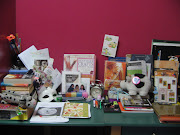*(from the handout Derrick gave us..)
For this term, our EAL/D assignment consists of making a short documentary (8-10 minutes) concerning current issues related to our community. The themes to choose from are:-
>Gender issue, e.g.- gender discrimination
>Poverty issue, e.g.-homelessness, squatter areas
>Ethnicity issue, e.g;-cross cultural conflicts
>Generational issue, e.g.-generation gap.
DEADLINE : 9/3/2009
We are also required to do a blog, which follows the current updates of our documentary-in-the-making. Here's a good example : http://www.noendpress.com/caleb/documentary_film/
Yowza.
Alright people, here goes. Hope to have a great time working with you all~
Before Shooting the Film
The starting point, is, of course to think of an interesting topic that all members of the group are enthusiastic about. ~be patient~
- Ask yourself:-
- WHY you want to make this film
- WHAT it is about
- WHERE the story is going.
- Find some examples that you can draw inspiration from before laying down the aesthetics and method of your film.
> Check these out :
http://www.sixmincin.com/competition/sample_shorts/index.html
http://www.openfilm.com/videos/generation_gap/
- Find a selection of different documentaries-- note the good elements.
- Do thorough research on your topic
- Make some test interviews before starting.
Map the different locations, and thus plan more precisely what you want in the film.
* There are different ways of structuring the material in a documentary-- see Toni de Bromhead's "Looking Two Ways" (1996). --She uses four narrative principles in her documentary.Slogan: Keep It Short & Simple (K.I.S.S.)
- The more precise your choices are, the more things you have excluded,---the more inspired you can be within the framework you have set yourself.
- The CAMERA plays a vital role. - Camera angles and movements are significant for the degree to which you express respect for/solidarity with/antipathy against, etc..
- Know the camrea before shooting..
- Camera movements shousld be-- calm or swift; on tripod or handheld; whether the person should be filmed from below, above, or at eye-level, etc.
It is a good idea to draw up a set of rules, some guidelines for what you can and cannot do. This will save you many discussions during the shoot and ensure you a fairly coherent style.
INTERVIEWS~
-Experiment with different interview techniques before shooting.
-try out different ways of asking and rephrasing questions. Do not omit any important information. Also, test different interview set-ups (lighting, positions of camera and microphone, etc...)
-Decide whether the film should have a visible inteviewer, or a hidden interviewer. Whether the person is a natural storyteller, or is dependent on the interviewer's response.
-Don't indicate that the interviewee didn't do well (even if this is the case). Instead, find some other excuses for re-shooting the scene; eg- the sound wasn't good enough, the picture was out of focus and so on..
-Let the interviewee finish his/her story. Show respect for what he/she is saying.
INTERVIEWER CHARACTERISTICS:
- Able to handle a 3-4 second pause between questions
- Make clear what he/she is talking about.
- Able to make the interviewee as comfortable as possible.
*Music...*
Deciding your choice of music can be very time-consuming. Your choice of music plays a very important part in the overall impression of the film, and these discussions should not be postponed until the editing phase. It is an important factor in creating a mood in the film.
- If you make a test film on location, try out different types of music with the filmed material.
STORYBOARDS~
- There will be a high degree of control when you make storyboards.
- Ensures the project is realistic within the given time.
- Reduce the risk of lacking important shots in the editing room.
The shooting phase
Make sure the picture pauses for 4-5 seconds every now and again-- this gives you a natural place to cut.
Avoid zooming--it is difficult to edit a shot that contains a zoom. If you need to get closer, it is better to move the camera.
Make the shots a little longer than intended--you never know what you might need in the editing room.
Be ready to switch the camera on if something unexpected happens- it might turn out to be a magical moment..
*Be ready to make changes-maybe even give up the original concept of the film (i.e. throw away the storyboard) if you find out what you had planned doesn't really work. This goes for the shooting phase as well as the editing phase.
The Editing Phase
Consider alternative ways of piecing the material together. Try to maintain a certain sensitivity towards the raw material in order to avoid forcing it in the wrong direction because you are too focused on the story you had planned to tell..
~The end
PS- Let us not pull each other's hair out!! (*__*)




No comments:
Post a Comment